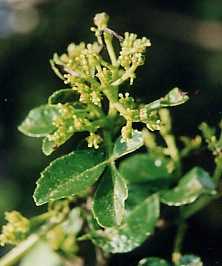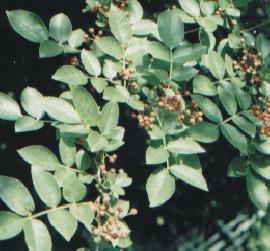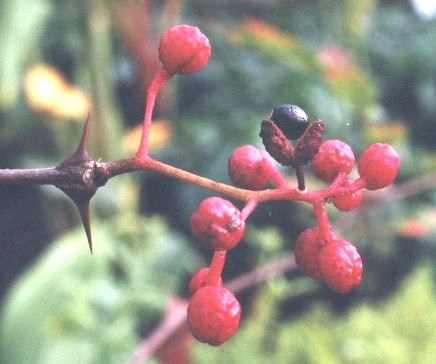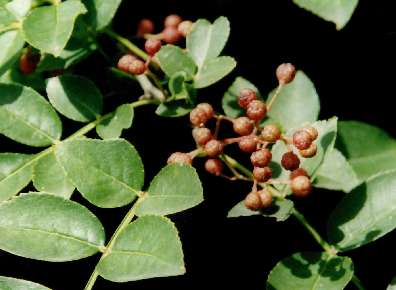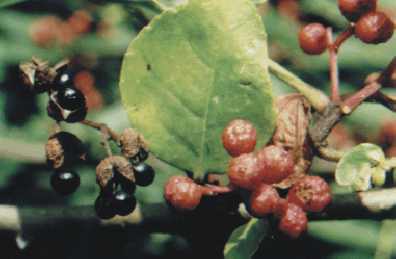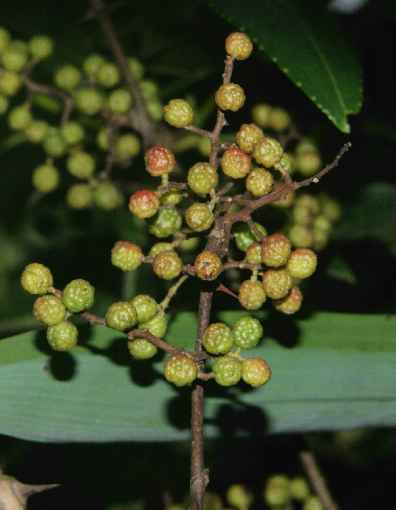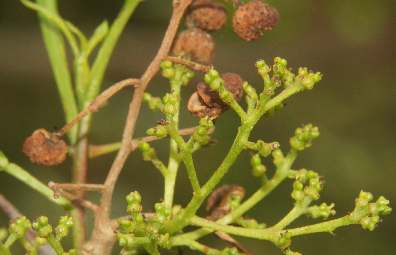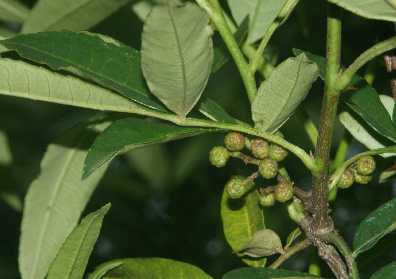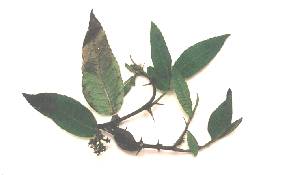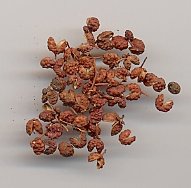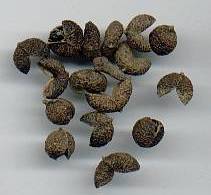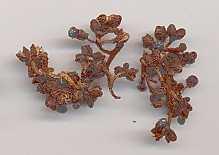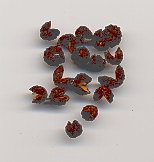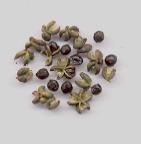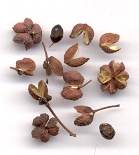Most Zanthoxylum species produce pungent alkamides
derived prom polyunsaturated carboxylic acids,
which are stored in the pericarp (fruit wall, shell
) but not in
the seeds. The exact nature of these alkamides may vary from
species to species, but common examples
are amides of 2E,6Z,8E,10E dodecatetraenoic acid,
2E,6E,8E,10E dodecatetraenoic acid, and 2E,4E,8Z,10E,12Z
tetradecapentaenoic acid with isobutyl amin (known as
α, β and γ sanshool, respectively)
and 2-hydroxy isobutyl amin (hydroxy sanshools), which have been
found in several different species of the genus. Total amide content
can be as high as 3% (reported in Z. piperitum).
Similar alkamides were found in a herb from
South America called paracress.
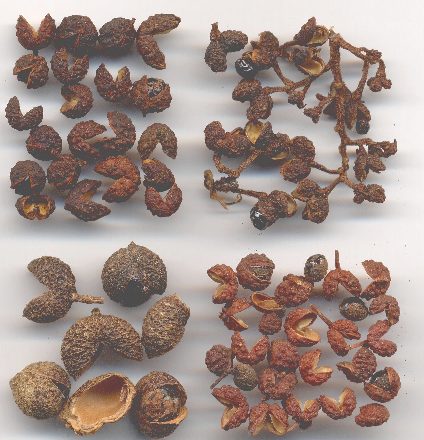
|
|
Four types of culinary Sichuan pepper:
Upper left Nepali timur (Zanthoxylum alatum),
upper right Indonesian andaliman (Z. acanthopodium),
lower left Indian tirphal (Z. rhetsa),
lower right Chinese jiao (Z.
piperitum/simulans) (200 dpi scan).
|
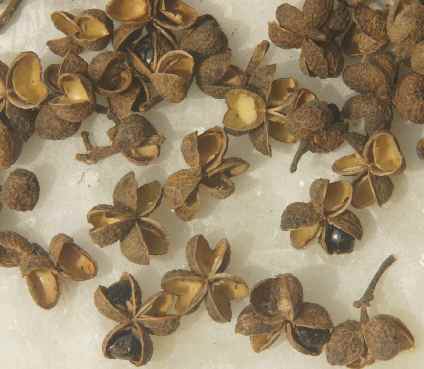
|
|
Zanthoxylum species from Nagaland
|
Within the genus, a bewildering collection of further, potentially interesting
nonvolatile constituents has been identified: flavonoids, terpene alkaloids,
benzophenthridine alkaloids, pyranoquinoline alkaloids, quarternary isoquinoline
alkaloids, aporphyrine alkaloids and several types of lignanes.
The typical flavour of Sichuan peppers is due to essential oils
which are, as a rule, mostly composed from terpenoids, but the
exact composition varies considerably among the species, and
sometimes even within the species. The following accounts on
Zanthoxylum essential oils can only give a
coarse overview on that matter.

|
|
Zanthoxylum species from Nagaland
|
The essential oil (up to 4%) of Chinese Sichuan pepper
(labelled as Z. piperitum, but could also be
Z. simulans or other) as sold in
Europe consists mostly of terpenes:
Geraniol, linalool, cineol, citronellal; also dipentene was found.
(Deutsch. Apoth-Zeit., 46, 2381, 1987)
The fruits of the Taiwanese species, Z. simulans, yielded
mainly β-myrcene, limonene, 1,8-cineol and (Z)-β-ocimene.
The total content of essential oil was reported to be 1.7% (steam distillation)
and 6.4% (carbon dioxide extraction).
(Journal of Agricultural and Food Chemistry, 44, 1096, 1996)
The leaves of Z. sansho (Japan, allegedly identical to
Z. piperitum) contain mostly monoterpene
derivatives (citronellal, citronellol) and unsaturated C6 compounds (e. g.,
Z-3-hexenal), which contribute to a grassy odour.
(Bioscience, Biotechnology and Biochemistry, 61, 491, 1997)
In the unripe fruits, the content of essential oil is reported to 0.6%, with
β-phellandrene (42%), d-limonene (23%) and β-pinene
(11%) being the main components. Terpene alcohols (geranyl acetate, citronellol,
α-terpineol) were found in the 1 to 5% range. The young leaves (0.12%)
yielded mostly terpene hydrocarbons.
(Nippon Nogeikakaku Kaishi, 70,1001, 1996)
The most abundant constituent in the essential oil of
Z. acanthopodium (Indonesia) is geranyl acetate (35%); the flavour
is, however, dominated by the citrus-scented compounds limonene and citronellal.
Further components are β-myrcene,
β-ocimene, linalool and E-1-decenal.
(H. Wijaya, personal communication)
(Food Science and Biotechnology, 11, 680, 2002)
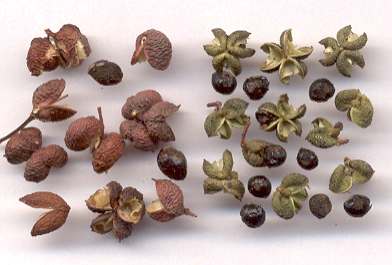
|
|
Two Zanthoxylum species used in Korean cooking: left chopi
(Z. piperitum), right sancho (Z. schinifolium)
(200 dpi scan).
|
The Korean species Z. schinifolium is particularly
interesting because it is almost non-pungent, and the essential oil
distributes evenly between pericarp and seeds. The essential oil
was shown to consist mainly of terpenoids (geraniol, limonene,
geranyl acetate, β‑phellandrene, phellandral, myrcene, linalool, α‑pinene), but
also nonterpenoid volatiles (p‑isopropyl-2‑cyclohexenone, caproic acid,
caprylic acid) and especially phenylpropanoids (anethole, eugenol, methyl
chavicol) have been found.
(Han’guk Sikp’um Yongyang Hakhoechi, 11, 493, 1998)
(Han’guk Sikp’um Yongyang Hakhoechi, 12, 119, 1999)
(Zhongguo Zhongyao Zazhi, 16, 359, 1991)
Z. alatum, a species growing in the Himalayas and figuring
prominent in Tibetan and Nepali cooking, is reported to contain mostly linalool
(more than 50%), further limonene, methyl cinnamate and cineol.
(Flavour and Fragrance Journal, 16, 408, 2001)
(Journal of Essential Oil Research, 10, 127, 1998)
Also in the Indian species, Z. rhetsa (syn. Z.
limonella), the essential oil (3.7%) has
been shown to consist mainly of monoterpene derivatives: Sabinene, limonene,
pinenes, para-cymene and terpinenes, furthermore the monoterpene
alcohols 4-terpineol and α-terpineol.
(Zeitschrift f. Lebensmitteluntersuchung und -forschung A, 206, 228, 1998)
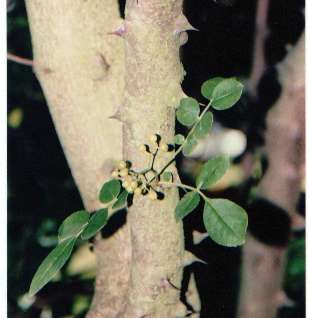
|
|
Sichuan pepper trunk with strong thorns
|
Another work on composition of the leaf oil found caryophyllene oxide (13%),
caryophyllene (10%), β-copaene (5%) and spathulenol (3%); the same authors
report sabinene (66%), α- and β-pinene (each 6%) and terpinen-4-ol
(4%) in the seed oil. Although the authors actually write
seed oil
, I suspect that the work refers to the essential oil obtained
from the pericarp.
(Journal of essential oil research, 12, 179, 2000)
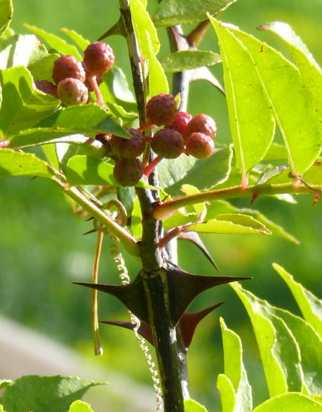
|
|
Sichuan pepper stem with fruits and prickles
© Laila Kolberg
|

|
|
Sichuan pepper trunk with strong thorns
|
Origin
The term Sichuan pepper
refers to a spice obtained form a group of closely
related plants of genus Zanthoxylum. In Asia, most representatives
of this genus are found in the Himalaya region, furthermore in Central, South,
South East and East Asia. American and African Zanthoxylum species
have not yet been put to culinary use.
The most important species are:
Z. piperitum DC = Z. sansho (Central and Eastern China, Japan, Korea),
Z. simulans Hance = Z. bungei (China, Taiwan),
Z. bungeanum Max. (China),
Z. schinifolium Sieb. et Zucc. (China, Korea),
Z. nitidum Roxb (DC) (China, peninsular South East Asia),
Z. rhetsa Pierre var. budranga Pier. = Z. limonella (Western North India, peninsular South East Asia),
Z. armatum DC = Z. alatum Roxb. (Himalaya, peninsular South East Asia, East Asia),
Z. avicennae (Lamk) DC = Z. tidorense (China, peninsular South East Asia, Indonesia) and
Z. acanthopodium DC (eastern Himalaya, China, peninsular South East Asia, Sumatra).
All species mentioned here have their place in local cuisines and can
(excepting Z. schinifolium)
mostly be used interchangeably. Literature often gives contradicting information
which spice is used where; furthermore, Zanthoxylum is a
difficult genus with many different, similar and not well-researched species.
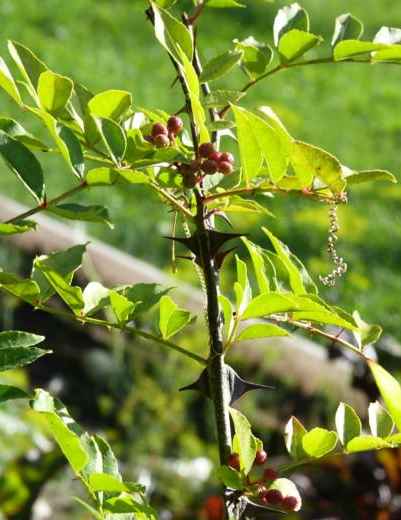
|
|
Chinese Sichuan pepper shrub
© Laila Kolberg
|
Etymology
Zanthoxylum is a dissimilated or probably simply false
modification of Greek xanthon xylon [ξανθὸν ξύλον], yellow wood
.
Cf. German Gelbholzbaum yellow-wood tree
and Polish
pieprz żółtodrzew yellow-tree pepper
(zółty yellow
and
drzewo tree
; see also juniper for the linguistic
affiliation of the latter).
Botanical species names of the species mentioned above are derived either by
local names (rhetsa, sansho) or are of Latin/Greek origin:
piperitus from Latin piper pepper
because
of the peppery taste; simulans
imitating
from simulare imitate
for the similarity to other
species; alatus winged
for the leaves’ shape;
nitidus shiny
, for the bright leaves;
armatus armed
, from arma weapon
for the
mighty thorns; further, acanthopodius thistle-footed
for similar reasons from Greek akantha [ἄκανθα] thistle, thorn
and pous [πούς] foot
; lastly schinifolius
because the foliage looks like that of Peruvian Pink
Pepper (Schinus molle).
The English name prickly ash refers on one side to the numerous thorns
of the plant (which are even commonly found in the dried spice), on the other
side to the pinnate leaves, which very much resemble those of ash (Fraxinus excelsior). English ash goes back to the
Indo–European name of this tree, H₃ES, and is, consequently, found in
many Indo–European tongues (Old English æsc,
German Esche, Old Norse askr,
Lithuanian uosis,
Armenian hatseni [հացենի],
Russian yasen [ясень]);
it must not be confused with its English homonym ash burned material
,
which derives (via Common Germanic ASKŌ)
from an Proto-Indo–European verbal root H₂ES burn
and also has relatives in nearly all Indo–European
languages: English arid,
German Esse chimney
,
Sanskrit ashani [अशनि] thunderbolt
,
Latin ara altar
(for fire-worshiping),
Greek azaleos [ἀζαλέος] dry, inflammable
.
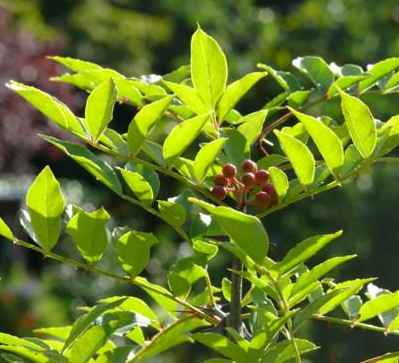
|
|
Sichuan pepper panicle
© Laila Kolberg
|
The North American species, Z. americanum, is known as
toothache tree
. Due to the anaesthetic power of its alkamide
constituents, the plant is effective in suppressing toothache temporarily
if unripe fruits or the wood of young branches are chewed. Another plant
rich in alkamides, paracress, has similar names.
The Chinese name of Sichuan pepper is jiao [椒];
to distinguish from other hot spices, the name is often expanded to
shan jiao [山椒] mountain pepper
,
hua jiao [花椒] flower pepper
or more rarely qin jiao [秦椒] Chinese pepper
and chuan jiao [川椒] Sichuan pepper
.
While most European tongues name the spice Sichuan-pepper
or
China-pepper
, one sometimes finds loan translations of the
first two names, e. g., Hungarian virágbors
flower pepper
or German Bergpfeffer mountain pepper
.
In Western literature, the Chinese name of Sichuan pepper is sometimes given als
fagara; in botanical taxonomy, that term denotes a related genus
(the name was introduced by Linnaeus in the 17.th century). The word originates
from a variant pronunciation of the logographs 花椒;
cf. the Cantonese reading fajiu. Possibly, fagara
stems from a related South Chinese dialect, or just goes back to an inaccurate
transcription of the Cantonese name.
Similar to English, which often uses the word pepper
to denote pungent
spices even if they are unrelated to pepper, Chinese often forms compound names
with the jiao element for such spices. Thus,
chile is la jiao [辣椒] hot Sichuan pepper
,
long pepper is chang jiao [長椒] long Sichuan pepper
,
paprika is tian jiao [甜椒] sweet Sichuan pepper
and allspice can be called gan jiao [甘椒] which also means sweet Sichuan pepper
.
The most important compound of that type is hu jiao [胡椒] wild pepper
, which can also be interpreted as foreign pepper
or barbarian’s pepper
.
which usually means black pepper, but
can be applied to Sichuan pepper, too. That compound name may also appear
in the name of pepperlike spices, e. g.,
hundred flavour wild (black) pepper
(bi wei hu jiao [百味胡椒], allspice) or
wild (black) pepper from the West
(ba xi hu jiao [巴西胡椒], pink pepper which is a spice native to America).
Tasmanian pepper is called
shan hu jiao [山胡椒]
wild (black) pepper of the mountain
, probably calqued on the English
name mountain pepper (a name used predominantly in Australia
for Tasmanian pepper).
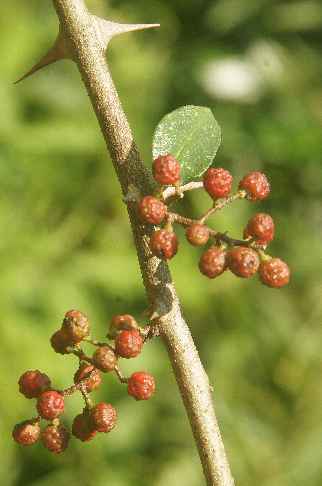
|
|
Ripening fruits of Nepalese Z. alatum
|
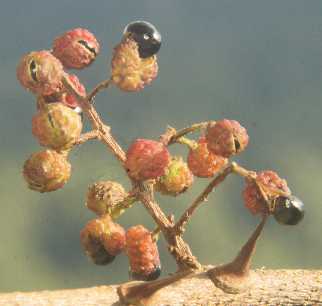
|
|
Ripe fruits of Nepalese Z. alatum
|
The name of the dish dry-fried lamb with three types of jiao
(sanjiao bao yangrou [三椒爆羊肉])
is due to that ambiguity: Green bell peppers (qing jiao [青椒] green pepper
)
and chiles (la jiao) are quickly fried
in a wok and sprinkled with toasted Sichuan pepper (hua jiao).
Chinese shan jiao [山椒]
is also the source of Korean sancho [산초];
note, however, that this name refers to a related spice with completely different
flavour. The spice corresponding to Chinese jiao is known as
chopi [초피] in Korean; this name also shows a syllable derived from
jiao.

|
|
Ripe fruits of Nepalese Z. alatum
|
Similarly, Japanese sanshō [山椒, さんしょう, サンショウ]
is adapted from Chinese shan jiao [山椒] mountain pepper
.
It is even spelt alike in Chinese and Japanese if the Japanese Kanji writing system is employed.
The Kanji sign 山
means mountain
also in Japanese, and like most Kanji, it has two
distinct readings: Alone and in mostly natively Japanese words it
is spoken yama (kun reading),
e. g. archaic yama-kujira [山鯨, やまくじら] wild boar
(literally mountain whale
) or in
seiyō-yama-hakka [西洋山薄荷, せいようやまはっか]
which is the Japanese name of lemon balm (literally foreign mountain-mint
).
Yet in words of Chinese origin one has to apply the
on-reading which goes san, e. g.
san-kei [山径, さんけい] mountain path
or the said name of Sichuan pepper, san-sho.
Occasionally, the Kanji reading is totally irregular, e. g., in
wasabi [山葵, わさび].
The Chinese term ma [麻] basically
means hemp fibre
(it can also denote hemp seeds or, by extension, sesame seeds); the
sign shows plants (lin [林] trees, forest
)
drying under a shed (chang [厂] factory, workhouse
).
Apparently, the narcotic properties of hemp motivated its use for the numbing flavour of Sichuan pepper.
Selected Links
The Epicentre: Szechwan Pepper
Nature One Health: Prickly Ash
chemikalienlexikon.de: Linalool
Recipe: Sangsang (saksang) (eng.ohio-state.edu)
Rezept von goccus.com: Shichimi tōgarashi [七味 唐辛子]
Recipe: Aurey Bendi (Indian Lima Beans) (groups.google.com)
Rezept von goccus.com: Shui zhu niu rou [水煮牛肉] (In Wasser gekochtes Rindfleisch)
Recipe: Shui zhu niu rou [水煮牛肉] (Sichuan water-boiled beef) (www.juoaa.org)
Rezept: Shui zhu niu rou [水煮牛肉] (In Wasser gekochtes Rindfleisch Sichuan-Art) (www.laohu.de)
Rezept: Shui zhu niu rou [水煮牛肉] (Rindfleischtopf Sichuan-Art) (chefkoch.de)
Recipe: Nepali Meat and Vegetable Momos (groups.google.com)
Sichuan Food’s Signature Fire Is Becoming Hard to Find — About the Ban of Sichuan Pepper in the USA
Sichuan is hot and spicy; the food too! (gluckman.com)
Gewürz-Bazar: Nepalpfeffer (timbur)
